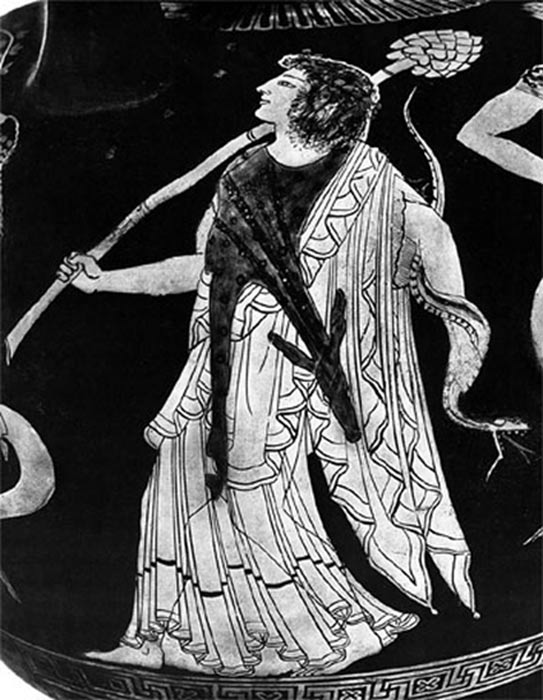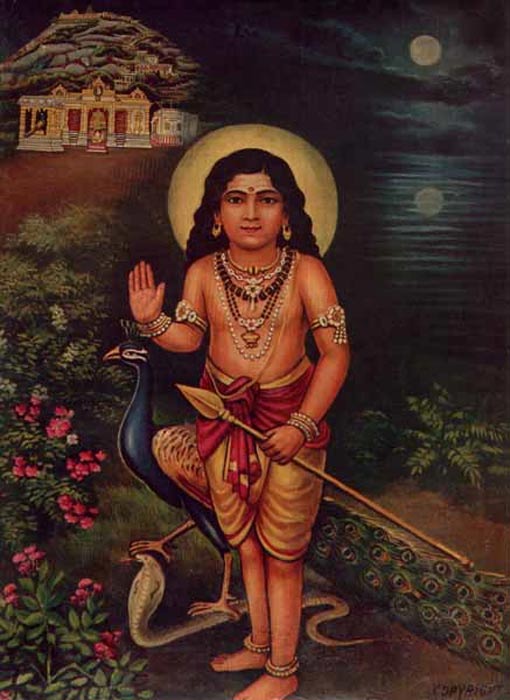
The Truth Behind the Christ Myth: The Green Man and the Legend of Jesus – Part II
So how did the oft-used legend of the Green Man eventually become chosen to be the legend of Jesus? Let us begin when it was the life story of the ancient Green Man and work forward to the time of the Christian Son of God.
The Hindu Divine Son
When the Greek conqueror Alexander the Great arrived in India he was surrounded by an abundance of rituals and venerated effigies of a Divine Son that reminded him of his beloved Dionysus. These reminders were so prevalent that that Alexander and his men were finally compelled to exclaim, “We know your Divine Son, he is also ours. We call him Dionysus.”

Dionysus with Thrysus Spear. (Public Domain)
In fact, so close was the Hindu Divine Son to Dionysus that a story arose that the Greek Son had himself either been born in India or spent much of his early upbringing there before going to Greece. A town named Nyssa, which is the same name as Dionysus’s birth town in the west, was subsequently discovered in India and the Divine Son of the Greeks and Hindus became synonymous. The name Dionysus denotes “the God of Nyssa.”
- The Celtic Goddess Epona that Rode Swiftly Across the Ancient Roman Empire
- Unraveling the Nature and Identity of the Green Man
- A Surprising Japanese Interpretation of the Lost Years of Jesus Christ
Similar to his counterpart, the forever young and effeminate Dionysus, the Hindus’ Divine Son was the pre-pubescent Murugan, meaning the “beautiful.”

His other names included Sanat Kumara and Karttikeya, a title denoting “Son of the Pleiades.” Both the Greek Dionysus and the Hindu Karttikeya were intimately associated with the Seven Sisters, who during their infancy manifested physically as their nursemaids. And like Dionysus, Karttikeya/Murugan had been born from the Earth mother, the Hindu Shakti, meaning “Energy,” through mating with the invisible Father in Heaven, Shiva.

Dionysus on cross with seven stars of the Pleiades above him. (Public Domain)
Both Dionysus and Murugan became monarchs of Earth, but they were also recognized as the greatest of warriors who carried and fought with versions of their favored weapon, the spear. Dionysus carried the Thrysus Spear and Murugan met his opponents on the battlefield with his Vel Spear. Both Dionysus and Murugan eventually became the commanders of great armies of righteous soldiers that fought for Zeus or Shiva, the Father in Heaven.

Dionysus with Thrysus Spear. (Public Domain)

Murugan with Vel Spear (Public Domain)
The Solar Heritage of Mitra
While Alexander and his men were linking Karttikeya and Dionysus, the counterpart of these two Divine Sons was being venerated in both India and then Persia. This was the Christed Son, Mitra. The name Mitra denotes friendship, contracts, mediation and balance.

The Solar God, Mitras. (Public Domain)
It refers to the balance that is created through the union of the universal male-female polarity. Like Karttikeya and Dionysus, Mitra was a product of the universal polarity. His mother was of the Earth and his Solar Father in Heaven was known by the name of Ahura Mazda. Both Murugan and Mitra explicitly displayed their solar heritage through their distinctive solar flags, as well as by counting the colorful cock as their most sacred animal. Recognized worldwide as the quintessential solar animal, the cock daily crows to ensure the rising of the morning Sun.

Mithra (left) in a 4th-century investiture sculpture at Taq-e Bostan in western Iran. (CC BY 2.5)
Mitra was eventually taken west by the Persians and then became known as Mithras, the beloved monarch-warrior-general of the Roman Legions. Mitra as Mithras became identified as the spirit embodied by the many Roman Emperors who sat upon the throne of the world while proclaiming themselves to be its universal king. By another name, Mithras was Sol Invictus, an epithet synonymous with the Solar Father in Heaven. In order to honor his beloved Mithras, the Emperor Charlemagne chose his day of Sunday, the day of the Sun, to be the holiest day of the week.
Jesus, incarnation of the Green Man
Now it is time to draw in the legend of Jesus, believed to be the Christian Son of God, who remains today one of the last incarnations of the ancient Green Man. His rise to fame began at the height of Mithras’s popularity, when a future Roman Soldier named Saul was born in Tarsus of Cilicia, the great bastion of Mithras worship in the Middle East. From a young age, Saul or Paul, was indoctrinated into the mysteries of Mithras by the Roman Soldiers, whom he daily served as their tent maker. While growing up in Tarsus, Paul learned from these soldiers that Mithras had been born in a manger to a virgin on December 25th and that he was surrounded by shepherds. He learned that Mithras was One with Ahura Mazda, the Father in Heaven, and had arrived on Earth to do his Father’s work. And he was informed that after a prolonged battle with Ahriman, the Evil One, Mithras gathered together 12 devotees for a Last Supper, during which a communion of wine and bread representing his blood and body were consumed by all those present. Mithras died soon after this event, but then he arose from the dead three days later. Then, while preparing for his Ascension, Mithras prophesied his return at the End of Time for one last battle against Ahriman.
- Ancient Signs in the Sky: Did a Meteorite Change the Course of Christianity 2,000 Years Ago?
- The Truth About the Holy Grail: Magical Chalices Around the World
- The Shroud of Turin: Controversial Cloth Defies Explanation as Study Shows it Has DNA From Around the World
When Paul was old enough he was sent to Jerusalem with other Roman Soldiers to guard some of the Jewish temples in the city. According to the early Christian historian Epiphanius, Paul was not a Jew when he subsequently arrived in Jerusalem, but converted to the faith after falling in love with the daughter of a Jewish priest and seeking her hand in marriage. When his proposal was subsequently rejected, Paul took out his rage on many Jews, including the Ebionites, the “Poor Ones,” a Jewish sect that championed the life story of a recently deceased Jewish holy man named Jeshua ben Joseph. When Paul learned the entire legend he soon began to associate Jeshua with the Persian Son. His suspicions of their special link grew stronger when he remembered a Persian prophecy – that Mithras would return to Earth at the End of Time for one last battle with Ahriman. According to the temple priests of Jerusalem, the world was at the end of the Age of Aries and the End of Times had indeed arrived, so it made perfect sense that Mithras would have incarnated as Jeshua.
The most convincing event that influenced Paul’s thinking was yet to come, however. This occurred during his journey to Damascus, when the Roman Soldier was blinded by an overwhelming light, and thrown off his horse. As an inveterate lover of Mithras, Paul would have instantly associated the intense light as being a manifestation of his beloved solar deity. And then, when a voice emerged from the light calling itself Jeshua and imploring him not to persecute his followers anymore, Paul knew for certain that Mithras must indeed be synonymous with Jeshua.

Detail, The Conversion of St. Paul. Paul and companions are knocked to the ground during the profound event. (Public Domain)
When Paul retired from military service soon afterwards he traveled throughout the Middle East in order to alert the gentiles of his discovery—that the world’s savior had come and gone—and in the process of his travels he created the new religion of “Christianity.” Within this new faith Mithras was fully assimilated into Jesus, who then wielded the life story, titles and characteristics once solely ascribed to the ancient Persian Son. His new titles included “One with the Father” and “the One and the Only Son of God.”
Thanks to Saint Paul and his Christ Myth, the ancient Green Man received a new suit of clothes. As Jesus, the ancient Green Man could now begin his tenure as one of the most adored religious figures the world has ever known.
Mark Amaru Pinkham is the author of six books that cover any of the world’s mysteries. They include: The Return of the Serpents of Wisdom, The Truth Behind the Christ Myth, Guardians of the Holy Grail, World Gnosis: The Coming Gnostic Civilization, and his most recent book , Sedona: City of the Star People. See the entire catalogue at: http://store.gnostictemplars.org/catalog/
Top Image: Green Man in the Louvre (CC BY-NC 2.0)
















Comments
Had hoped to see some astounding fallacies and BS to dispel Christ as true.
But did not expect to see so much distortion and in vitro fertilization of facts and myths.
Anyways well edited piece of fiction.
BTW, if similar articles about Indian deities are written, the author would never be able to sell his books here.
Do not know what exactly you are refering.
Only thing that is true in this article are names of pagan gods.
There is obviously much to be argued in the details, but the main premise that there are many correlations to be found in myths throughout human culture which have surely been misinterpreted, corrupted, exaggerated, and manipulated for thousands of years
holds much credibility.
Debating exact chronologies is really just a further distraction more than it is a disproving.
I agree that there is alot of inaccuracy here my friend, but where do you stand on the premise?
This is totaly not true.
Lets start from the start of article.
Greek religion has nothing to do with Hinduism. There is no god in Hinduism called "Divine Son". When you write, invent that Alexander mixed Dionisius mythology with Hindu Murugan you must know that this Murugan is post Vedic god and there was no that god in period of Alexander in India. When Alexander came to India they belived in Vedic gods, not post Vedic gods. Also, there was no Shiva in Vedic pantheon. Also, Mughar is god of war in Hindu pantheon, and he was born by Paravati (she is not hindu god of earth) and Shiva (he is not divine father, sky father, but destroyer). You are totaly wrong in all this.
This representation of Bachus on cross is modern forgery. Also, there is no crucifiction of Bachus in greek or Roman mythology. Forgery.
Dinonisius fought for Zeus. No. He was not god of war, like Murugan was in Hindu religion. Dionisius is not Greek god of war also.
This representation of Sun in chariot is not Mithra, but Roman Sol invictus.
Mithra was not born from Ahura Mazda. He was born from stone, no father, no mother. Mithra was incorporated in Roman, Greek pantheon in 2nd, 3rd century because their hate for Persian things. Mithra was not Roman Sol invictus. Sunday is Roman day of Sun, and there is no relation with Mithra in it. Charlemagne took Sunday because on that day Christ was resurected - Son of rightesness, "eternal Sun" not this corapted material Sun. You see Sun is symbol of God, and not the other way around. People must understand that. God is not symbol of Sun, Sun is symbol of God.
Mithra is not born on december 25, there was no shepards, his father is not Ahura Mazda and so on. All not true what you write. It was not in their religion. Since in 2nd, 3rd century Mithra came to Roman, Greek pantheon and they could incorporate much elements from Christianity and not the other way around.
This story about Paul is all made up, modern, gnostic invention story.
Conclusion. This article is 100% made up. Only true here are names of gods.
Pages